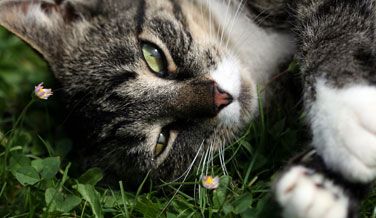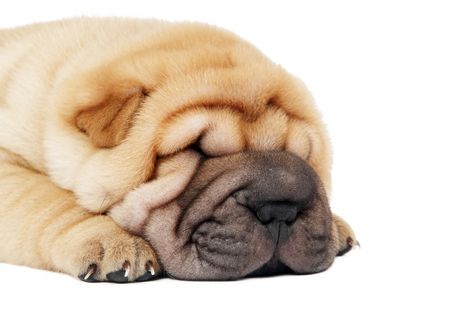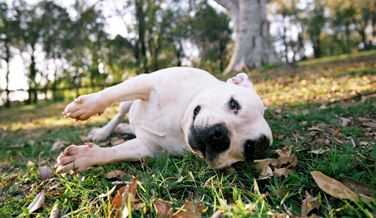QUALITY VETERINARY EYE specialist AT A FAIR COST
TO GIVE YOUR LOVED ONES A BETTER LIFE
Cataracts
What is a Cataract?
Cataracts are opacities in the lens of the eye. Many people mistakenly think the cloudiness is on the surface (thought to be a “film” on the eye), but in fact, the cloudy lens is deep inside the eyeball. The lens of a dog is approximately one half inch (15 mm) in diameter and a third of an inch thick (9 mm). It sits behind the iris and pupil. As dogs approach 8-10 years of age, the lens naturally becomes more cloudy (blue-grey in color) due to the aging process. This is not the same a cataract, which typically appears white in color. The aging change is called nuclear sclerosis and causes difficulty with close-up focus on objects. It is important to realize that normal dog vision is not as sharp as ours. A dog typically has visual acuity of 20:70 whereas 20:20 is normal for a person.
Why Did My Pet Get Cataracts?
The most common cause of cataracts is aging. Thankfully few aging cataracts in dogs become severe enough to require surgery to restore functional vision. Some cataracts in dogs are inherited. Breeds such as the Cocker Spaniel, Poodle, Husky, Miniature Schnauzer, Golden and Labrador Retrievers, and Terriers are often affected. Other causes of cataracts include: diabetes, trauma, inflammation, and puppy milk replacers. Many cataracts will worsen to the point of blindness. Certain types, especially in the retriever breeds, can remain small for the entire life. A common phenomenon occurs in many developing cataracts where the patient can develop an allergic type of reaction to the animal’s cataract. This allergic reaction is a LOCAL reaction and can result in many complications such as iris and pupil adhesions, chronic scleral redness.
How Are Cataracts Treated?
Theoretically, early cataracts could be reduced or stabilized by treatment with antioxidants (e.g. grape seed extract). However, the effectiveness of this type of treatment is difficult to measure.
If a cataract is severe enough to cause vision loss or will soon become severe enough, the only treatment is surgical removal. This may be done in one or both eyes depending on the specifics of each patient. Before surgery is performed, special tests beyond the full eye exam will be used to check retinal health in the back of the eye. If these tests are not passed, removal of the cataracts would either not improve vision or may create a significant risk of problems after surgery and the surgery wouldnot be recommended.
Cataract surgery is elective and requires a significant time commitment on your part. Eye drops must be administered several times daily for a few weeks before surgery and for about 6 weeks after surgery. The postoperative checkups are usually performed the day after surgery and then one, three, and six weeks after surgery. These rechecks can be performed by myself or through your regular veterinarian. Usually a long term checkups is made about 4 months after surgery and then once a year. The success rate is 95% but as with any surgery there are risks.
The surgery is performed under general anesthesia and we are proud of our anesthetic protocols and monitoring systems. The anesthetics are state-of-the-art medications that are used in human hospitals and all patients’ pulse rate, oxygen levels, and blood pressure are monitored throughout the surgery by a technician. After surgery we monitor the eye pressure for any pressure spikes and control this (usually temporary) problem with medicine. We make every effort to avoid any complications but as with any surgery in any species these risks do exist.
Depending on the specifics of your pet’s cataracts, age, and cause we perform either a small incision technique (phacoemulsification) or a large incision method (extracapsular cataract extraction). The small incision technique is performed in over 90% of our patients and carries the benefits of shorter surgery and healing times. Often we will remove cataracts in each eye at the same surgery. Phacoemulsification is the same technique performed for human cataract removal; the tiny probe breaks up the cataract with ultrasonic vibration and draws out the cataract particles. Many people believe that cataract removal is done with a laser but that is incorrect!! After removal of the cataract(s) we can replace the lens with an artificial lens. Without an artificial lens a dog will be farsighted (better vision at distances of 3-15 feet) and have approximately 20:120 vision. This means detail recognition for the dogat 20 feet would be what we would see at 120 feet. If a dog is active and enjoys playing fetch and catch games, lens replacement may be of significant value due to the sharper vision that results (20:70). Older dogs that are fairly quiet, may not benefit as much from having an artificial replacement lens.
What will my pets’ vision be like after surgery?
Regardless of whether an artificial lens is inserted, your pet will not be able to adjust the ocular focal point and will see best when objects are 10-20 feet away. Basically they would need bifocals to allow for clear vision of close-up objects. However, most dogs are able see objects approximately 1/4″ in diameter at a distance of several feet. The downside is that distance vision beyond 30-50 feet may not be as sharp as before the cataracts developed. Overall, your pet should be able to do most tasks that are expected and thus be a functional part of the family.
Please feel free to ask further questions about cataracts to our outstanding support staff.
Our Services
Our doctors will perform a complete eye examination on your pet with the assistance of our nurses. This includes examining the eye with a head set, hand lens, panophthalmoscope and slit lamp to aid in magnification of different parts of the eye.
Companion Animal Eye Registry
The purpose of the OFA Companion Animal Eye Registry (CAER) is to provide breeders with information regarding canine eye diseases so that they may make informed breeding decisions in order to produce healthier dogs.
Contact Us
Learn more about any of the animal eye care es we offer and current availability.




